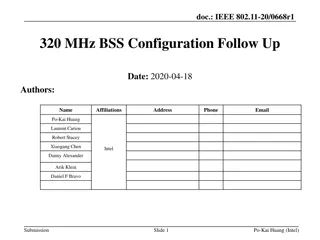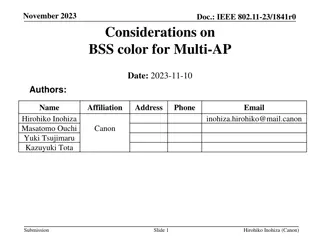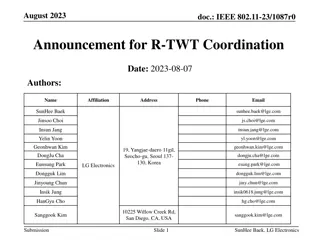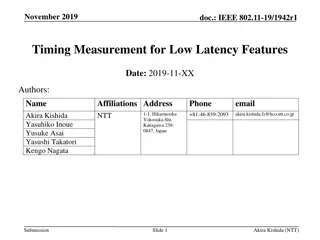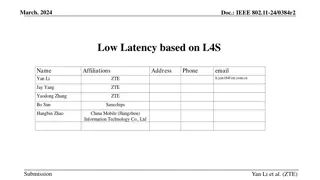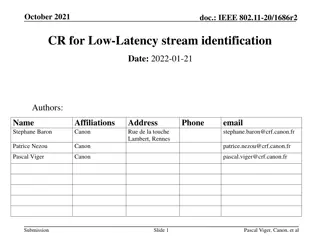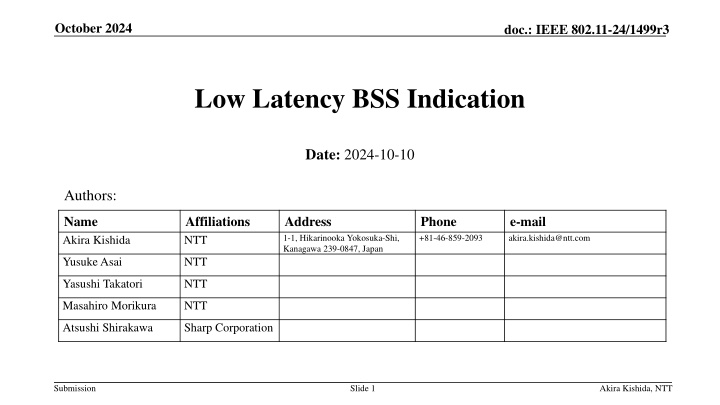
IEEE 802.11-24 Low Latency BSS Indication Proposal
Explore the proposal for a signaling method in IEEE 802.11-24 to distinguish BSSs supporting low latency traffic. The initiative aims to enhance technology effectiveness by indicating BSSs designated for low latency applications, facilitating better traffic management for various use cases like industrial IoT and robotics.
Download Presentation

Please find below an Image/Link to download the presentation.
The content on the website is provided AS IS for your information and personal use only. It may not be sold, licensed, or shared on other websites without obtaining consent from the author. If you encounter any issues during the download, it is possible that the publisher has removed the file from their server.
You are allowed to download the files provided on this website for personal or commercial use, subject to the condition that they are used lawfully. All files are the property of their respective owners.
The content on the website is provided AS IS for your information and personal use only. It may not be sold, licensed, or shared on other websites without obtaining consent from the author.
E N D
Presentation Transcript
October 2024 doc.: IEEE 802.11-24/1499r3 Low Latency BSS Indication Date: 2024-10-10 Authors: Name Akira Kishida Affiliations NTT Address 1-1, Hikarinooka Yokosuka-Shi, Kanagawa 239-0847, Japan Phone +81-46-859-2093 e-mail akira.kishida@ntt.com Yusuke Asai NTT Yasushi Takatori NTT Masahiro Morikura NTT Atsushi Shirakawa Sharp Corporation Submission Slide 1 Akira Kishida, NTT
October 2024 doc.: IEEE 802.11-24/1499r3 Introduction The UHR PAR and CSD [1][2] indicate that IEEE 802.11bn should support use cases such as, logistics, and smart agriculture. robotics, industrial automation for industrial IoT. Most STAs deployed in these use cases require low latency, and various technologies for reducing latency are discussed in TGbn. To enhance the effectiveness of those technologies, we propose a signaling method to notify whether the BSS is intended for low latency traffic or not. This contribution is the updated version of the use case indication for 11bn features on 24/0837 [3] based on many valuable comments from offline. Submission Slide 2 Akira Kishida, NTT
October 2024 doc.: IEEE 802.11-24/1499r3 Motivation The UHR PAR defines throughput, latency, and MPDU loss as reliability. However, the relationship between increasing throughput and improving latency is a tradeoff. Which KPI is most important relies on the service or application [4]-[6]. It is preferable to separate low latency traffic from non-low latency traffic as much as possible because each type of traffic has a different KPI. If we have some indicators that will help separate BSSs treating low latency traffic from those treating non-low latency traffic, the guidance for STAs in associating the appropriate BSS based on the type of traffic will be enabled. Submission Slide 3 Akira Kishida, NTT
October 2024 doc.: IEEE 802.11-24/1499r3 Problem statement Latency Sensitive use cases such as industrial automation, robotics, and cloud gaming require stringent latency but do not have high data rates. [7] In such use cases, the occupancy of long TXOPs for non-low latency traffic degrades the latency characteristics of low latency traffic by blocking the wireless medium for a long duration. Use cases Intra BSS latency [ms] Jitter variance [ms] Packet loss Data rate [Mbps] Real-time gaming < 5 < 2 < 0.1 % < 1 Cloud gaming < 10 < 2 Near- lossless < 0.1 (Reverse link) > 5Mbps (Forward link) Real-time video < 3 ~ 10 < 1~ 2.5 Near- lossless 100 ~ 28,000 Equipment control < 1 ~ 10 < 0.2~2 Near- lossless < 1 Robotics and industrial automation Human safety < 1 ~ 10 < 0.2 ~ 2 Near- lossless < 1 This long TXOP set by STA 2 generates a critical delay on STA 1 s low latency (LL) transmissions. TXOP owned by STA 2 Haptic technology < 1 ~ 5 <0.2~2 Lossless <1 Drone control < 100 <10 Lossless <1 >100 with video LL LL LL LL STA 1 Sporadic low latency traffic Non-LL Traffic STA 2 Submission Slide 4 Akira Kishida, NTT
October 2024 doc.: IEEE 802.11-24/1499r3 Problem statement cont d Non-latency sensitive use cases, such as most cases using best effort traffic, require high data rates and throughput. Interrupting those transmissions by prioritizing latency sensitive transmissions causes throughput degradation of non-low latency traffic. Periodic low latency traffic Chance of transmission for non-low latency (non-LL) traffic are decreased because periodic and sporadic low latency transmissions are prioritized and secured. STA 1 LL LL LL LL LL LL (Low latency traffic) R-TWT SP STA 2 BE BE BE BE (Non-low latency trafffic) Submission Slide 5 Akira Kishida, NTT
October 2024 doc.: IEEE 802.11-24/1499r3 Proposed Solution Proposed solution: Each BSS broadcasts and notifies whether it is planned to be used for low latency traffic. Unlike licensed systems, IEEE 802.11 WLANs are planned as distributed networks and are impossible to separate by intended use. However, by indicating that the BSS is intended to be used for low latency traffic, the BSS provides STAs with an indication of how to select a network that suits their purpose, allowing for a slack separation of associations. This feature can be compared to "traffic lights with no legal force." This feature does not prohibit STAs that do not have low latency traffic from associating with an AP MLD for low-latency traffic, nor does it prohibit STAs that have low-latency traffic from associating with an AP MLD for non-low-latency traffic. Suppose associations of STAs to AP MLDs other than those intended for use are not allowed. In that case, there are concerns that associations will be concentrated on a specific AP MLD, or STAs cannot use a Wi-Fi connection if there are no other AP MLDs to associate with. Submission Slide 6 Akira Kishida, NTT
October 2024 doc.: IEEE 802.11-24/1499r3 Proposed Solution cont d For an example of an operation, a BSS for low latency traffic can set its TXOP limit to a lower value than usual and broadcast it with a low latency BSS indication. Advantages - AP side Gentle traffic control can be enabled, especially in MLO. OBSSs can select another channel as their operating channel to avoid using the same channel as the BSS for low latency traffic. Advantages - STA side Appropriate association to the AP can be made according to the type of traffic. The inconsistency of KPIs (latency, throughput) between APs and STAs can be resolved. AP MLD indicates whether each link is planned to be used for low latency traffic or non-low latency traffic, respectively. AP MLD Link #1-2 (for non-low latency) Normal TXOP limit Low latency BSS Shorter TXOP limit Non-low latency BSS Normal TXOP limit Can set or change the operating channel to avoid using the same channel for low latency BSS. Link #3 Indicates that this BSS is for low latency traffic (for low latency) Shorter TXOP limit STAs with low latency traffic are encouraged to associate with low latency BSS. STAs with non-low latency traffic are avoided to associate with low latency BSS. STAs (AGVs) STAs STAs (AGVs) STAs (Smartphones) (Smartphones) Submission Slide 7 Akira Kishida, NTT
October 2024 doc.: IEEE 802.11-24/1499r3 Use of Interworking element for indication To realize this mechanism for indication of low latency network, it is preferable to reuse and extend the existing information elements (IEs) rather than define new information elements or signaling mechanisms. This will mitigate the impact to the 11bn spec. We propose to use and update the Interworking element defined in 11u and utilized for Hotspot 2.0 (Passpoint). This IE is utilized for active scanning for DMG STAs, generic advertisement service (GAS) protocol, WLAN interworking with external networks procedures, and access network query protocol (ANQP). Submission Slide 8 Akira Kishida, NTT
October 2024 doc.: IEEE 802.11-24/1499r3 Utilize a reserved value of access network types field for low latency BSS. Interworking element (defined in 11u) The Access Network Options field in the Interworking element can identify the type of access network, such as private or public networks. The Values 6 to 13 in Access Network Type in the Access Network Options field are reserved for future use. We can utilize one of the reserved value in the Access Network Options field for the indication of low latency BSS. These values are reserved for future use. Access network type Meaning Description This reserved value can be utilized to indicate low latency BSS. 6 (TBD) Low latency BSS (TBD) This BSS is intended to utilize low latency traffic and may set related parameters and functions for low latency traffic (TBD). Submission Slide 9 Akira Kishida, NTT Akira Kishida, NTT
October 2024 doc.: IEEE 802.11-24/1499r3 Summary To increase the effectiveness of the low latency features discussed in TGbn and to achieve the high reliability specified in the PAR, it is desirable to separate low latency traffic and non-low latency traffic as much as possible without mixing them. Occupying TXOP for a long period may cause significant latency degradation. Also, prioritizing low latency traffic may prevent non-low latency traffic from obtaining a transmission chance, which may degrade throughput characteristics. Indicating whether the BSS is for low latency traffic or non-low latency traffic enables STAs to select an appropriate BSS, thereby increasing the effectiveness of the low latency features discussed in TGbn. We propose to use and update the existing Interworking element to realize it. This has little impact on the 11bn specs. Submission Slide 10 Akira Kishida, NTT
October 2024 doc.: IEEE 802.11-24/1499r3 Q&A What usages or use cases are assumed? We assume that this feature is effective for enterprises, stadiums, or use cases newly introduced in the UHR PAR (industrial, logistics, and so on). If area owners can manage the whole network completely and exclude non-manageable APs or STAs, there is no need to deploy this feature. However, some OBSSs and STAs that area owners cannot control might exist in real environments. How decide the low latency BSS? It will depend on the area owners and be left for operation. In other words, the definition of low latency BSS will not be determined because this feature is not for control but for guidance. Area owners can decide according to their intentions. What is the difference between low latency BSS and non-low latency BSS? It depends on the configuration of the low latency BSS. For example, the TXOP limit of the low latency BSS can be shortened, and specified low latency features (e.g., preemption, C-RTWT) can be enabled. Submission Slide 11 Akira Kishida, NTT
October 2024 doc.: IEEE 802.11-24/1499r3 Q&A cont d Is it enough to know low latency-related IEs in a beacon frame? We think not. Capabilities don't inform the purpose of using the BSS. Even if the AP MLD supports latency- related features, it is not always used for low latency traffic. Moreover, a beacon frame contains a variety of IEs, and it is complicated to give a general judgment of their usage. This feature can inform the usage of the BSS without considering all related IEs. How does this feature work if we want to indicate both an existing Access Network Type and a low-latency BSS? It is impossible to enable both indications. However, existing values of Access Network Type will be utilized for non-latency-related traffic, such as Internet traffic, except emergency services-only networks. Therefore, indicating low latency BSS will not seriously impact the existing use of the Interworking element. Is this indication broadcasted by either an AP MLD or an affiliated AP in the AP MLD? It depends on the implementation, but we assume this indication is contained in the Interworking element in a Beacon frame. Submission Slide 12 Akira Kishida, NTT
May 2024 doc.: IEEE 802.11-24/1499r3 SP Do you agree to define one of the reserved values of the Access Network Type field in the Access Network Options field in the Interworking element as a low latency BSS? Note: The name of the Meaning and Description are TBD. -Yes -No -Abstain Submission Slide 13 Akira Kishida, NTT
October 2024 doc.: IEEE 802.11-24/1499r3 Reference [1] Akira Kishida, et al., Indication of Use Case in 11bn, IEEE 802.11-24/0837r3 [2] Laurent Cariou, et al., UHR proposed PAR, IEEE 802.11-23/0480r3 [3] Laurent Cariou, et al., IEEE 802.11 UHR Proposed CSD, IEEE 802.11-23/0079r10 [4] Akira Kishida, et al., KPIs for Industrial Automation Use Cases, IEEE 802.11- 23/0292r1 [5] Akira Kishida, et al., Consideration of Industrial Automation Scenarios, IEEE 802.11- 23/0815r0 [6] Akira Kishida, et al., Consideration of Industrial Automation Scenarios - Follow Up, IEEE 802.11-23/1947r0 [7] Kate Meng, et al., RTA report draft, IEEE 802.11-18/2009r6 Submission Slide 14 Akira Kishida, NTT
October 2024 doc.: IEEE 802.11-24/1499r3 APPENDIX Submission Slide 15 Akira Kishida, NTT
May 2024 doc.: IEEE 802.11-24/1499r3 Access Network Type and Venue Group Submission Slide 16
May 2024 doc.: IEEE 802.11-24/1499r3 Venue Type Submission Slide 17



